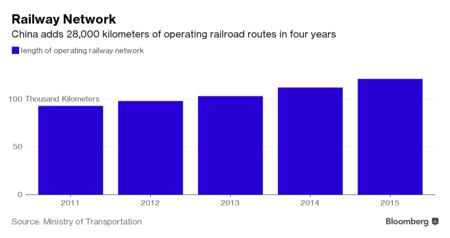President-elect Donald Trump has proposed spending up to $1 trillion over a decade to make America's infrastructure "second to none."
Except for China that is.
The world's second-largest economy has already topped that this year alone, with $1.4 trillion splurged on roads, railways, bridges, telecom networks and other infrastructure in the ten months through October.
Trump's plan for an "America's Infrastructure First" policy mirrors China's build-it-and-they-will-come model, except on a much smaller scale. China has spent about $11 trillion on infrastructure in the last decade -- more than 10 times what Trump is proposing. Some economists reckon it needs to spend about $2 trillion a year going forward to keep economic growth humming at today's level.
That building binge has transformed China's continent-sized economy. Its 20,000 kilometers of high-speed railways account for more than 60 percent of the world's total, and it's not done yet, with plans to boost that distance to 30,000 kilometers by 2020. The U.S.? Don't ask.
Except for China that is.
The world's second-largest economy has already topped that this year alone, with $1.4 trillion splurged on roads, railways, bridges, telecom networks and other infrastructure in the ten months through October.
Trump's plan for an "America's Infrastructure First" policy mirrors China's build-it-and-they-will-come model, except on a much smaller scale. China has spent about $11 trillion on infrastructure in the last decade -- more than 10 times what Trump is proposing. Some economists reckon it needs to spend about $2 trillion a year going forward to keep economic growth humming at today's level.
That building binge has transformed China's continent-sized economy. Its 20,000 kilometers of high-speed railways account for more than 60 percent of the world's total, and it's not done yet, with plans to boost that distance to 30,000 kilometers by 2020. The U.S.? Don't ask.
To be sure, as a developing nation, China still has much potential for more building compared with an advanced economy such as the U.S.

China's number of civilian airports increased from 180 in 2011 to 210 last year; the last major new U.S. airport to be completed was back in 1995.

Indeed, for China, the problem isn't too little infrastructure investment -- it may be too much. Vacant apartment towers, empty industrial zones and underused airports in far flung provinces have to be paid for one day, and the pile of debt used to fund it all just keeps on growing. And increasing government investment cuts against pledges to give markets a bigger say in China's economic future.

The efficiency of the infrastructure binge is also in question. More than half of China's infrastructure investment has destroyed economic value instead of generating it, according to a study from the University of Oxford's Saïd Business School.
With the average age of America's fixed assets 22.8 years -- the oldest in data back to 1925 -- the plan to boost infrastructure spending is drawing support for now.
But when it comes to infrastructure, "America First" is actually a distant second.
— With assistance by Xiaoqing Pi
